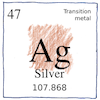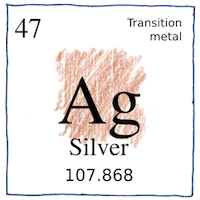Asia Minor
elements

|
Silver
Moonlight made into ornaments utensils and coins galore. Actually, we’re thinking about silver; silver’s only like moonlight. Ductile, reflective, and cheaper than gold, silver’s a dream that happens for real. Serving, since the fourth millennium, the need for fine metal in people’s lives.
Atomic number 47
Separated from lead in Asia Minor and on the islands of the Aegean Sea Mined in Sardinia in early Chalcolithic, the Copper Age, from 3200 BCE Mined in Laurium for the Athenian state from the sixth century BCE and worked by thousands of slaves The Chinese used it to store wealth and as a medium of exchange With silver mines in Hispania and Britannia, the Roman economy relied on it greatly. * Used in ornaments and candlesticks, utensils, and coins photovoltaic panels, water purifiers, dental amalgams, photography and electronics mirrors, window glazings, musical instruments, and antibiotic coatings.
Stuff that tarnishes
Contrary to common assumptions, the British Pound Sterling is brass and nickel and the U.S. quarter and dime are copper and nickel. Ah, you say. There’s a difference between the real thing, made of base metals, and the ideal, which can not tarnish. True, but I happen to notice when men grow old they grow more cynical and you can’t buy food with ideals. If you expose a silver urn to air and hydrogen sulfide, over time, it tarnishes, so get used to it or polish it regularly.



The alchemists found an affinity between silver, the goddess Luna, and the moon, but silver is totally unrelated to lunacy.
See also in The book of science:
Readings in wikipedia:
Other readings: